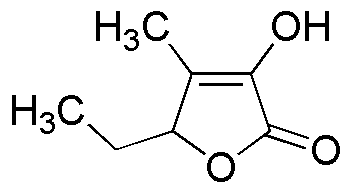5-Ethyl-3-hydroxy-4-methyl-2(5H)-furanone is widely utilized in research focused on:
- Flavoring and Fragrance Industry: This compound is commonly used as a flavoring agent in food products, providing a sweet, fruity aroma that enhances the sensory experience of various consumables.
- Cosmetics and Personal Care: Its pleasant scent makes it a popular choice in cosmetic formulations, contributing to the fragrance of lotions, creams, and perfumes, thereby improving customer appeal.
- Aromatherapy Products: The compound is also found in aromatherapy oils, where its calming properties can help promote relaxation and well-being, making it a favorite among wellness enthusiasts.
- Pharmaceuticals: In medicinal chemistry, it serves as a building block for synthesizing more complex molecules, aiding in the development of new therapeutic agents.
- Research Applications: Scientists utilize this compound in various studies related to flavor chemistry and sensory analysis, helping to understand consumer preferences and improve product formulations.
General Information
Properties
Safety and Regulations
Applications
5-Ethyl-3-hydroxy-4-methyl-2(5H)-furanone is widely utilized in research focused on:
- Flavoring and Fragrance Industry: This compound is commonly used as a flavoring agent in food products, providing a sweet, fruity aroma that enhances the sensory experience of various consumables.
- Cosmetics and Personal Care: Its pleasant scent makes it a popular choice in cosmetic formulations, contributing to the fragrance of lotions, creams, and perfumes, thereby improving customer appeal.
- Aromatherapy Products: The compound is also found in aromatherapy oils, where its calming properties can help promote relaxation and well-being, making it a favorite among wellness enthusiasts.
- Pharmaceuticals: In medicinal chemistry, it serves as a building block for synthesizing more complex molecules, aiding in the development of new therapeutic agents.
- Research Applications: Scientists utilize this compound in various studies related to flavor chemistry and sensory analysis, helping to understand consumer preferences and improve product formulations.
Documents
Safety Data Sheets (SDS)
The SDS provides comprehensive safety information on handling, storage, and disposal of the product.
Product Specification (PS)
The PS provides a comprehensive breakdown of the product’s properties, including chemical composition, physical state, purity, and storage requirements. It also details acceptable quality ranges and the product's intended applications.
Certificates of Analysis (COA)
Search for Certificates of Analysis (COA) by entering the products Lot Number. Lot and Batch Numbers can be found on a product’s label following the words ‘Lot’ or ‘Batch’.
*Catalog Number
*Lot Number
Certificates Of Origin (COO)
This COO confirms the country where the product was manufactured, and also details the materials and components used in it and whether it is derived from natural, synthetic, or other specific sources. This certificate may be required for customs, trade, and regulatory compliance.
*Catalog Number
*Lot Number
Safety Data Sheets (SDS)
The SDS provides comprehensive safety information on handling, storage, and disposal of the product.
DownloadProduct Specification (PS)
The PS provides a comprehensive breakdown of the product’s properties, including chemical composition, physical state, purity, and storage requirements. It also details acceptable quality ranges and the product's intended applications.
DownloadCertificates of Analysis (COA)
Search for Certificates of Analysis (COA) by entering the products Lot Number. Lot and Batch Numbers can be found on a product’s label following the words ‘Lot’ or ‘Batch’.
*Catalog Number
*Lot Number
Certificates Of Origin (COO)
This COO confirms the country where the product was manufactured, and also details the materials and components used in it and whether it is derived from natural, synthetic, or other specific sources. This certificate may be required for customs, trade, and regulatory compliance.


